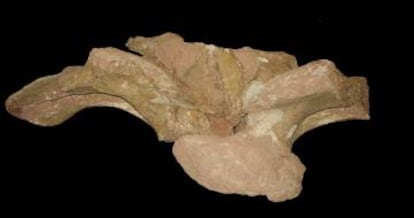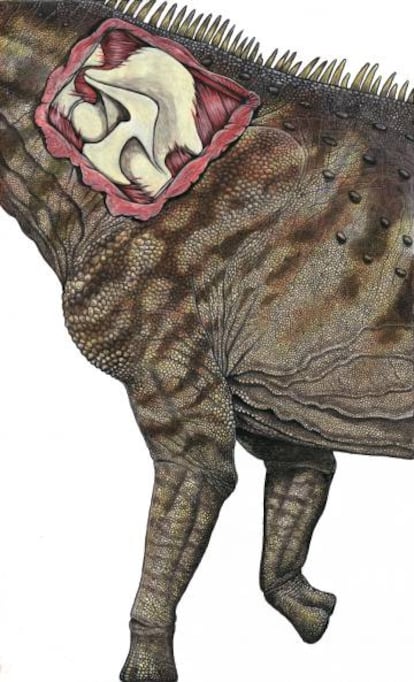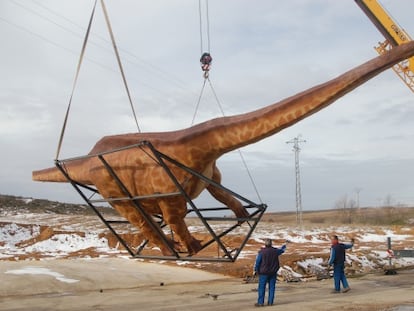The Brazilian monster that looked down on ‘Tyrannosaurus rex’
Paleontologists identify ‘Austroposeidon magnificus,’ which would have stood eight meters tall


When dinosaurs ruled the earth, they walked tallest in Brazil, say paleontologists from the Museum of Earth Sciences in Rio de Janeiro, who have just concluded that the planet’s biggest specimen ever found lived there.
The team says that Austroposeidon magnificus was a herbivore that lived about 70 million years ago, during the late Cretaceous period, in the woodlands and swamps of southern Brazil. It measured 25 meters in length and towered some eight meters tall. To put that in context, the legendary Tyrannosaurus rex was just five meters high and 13 meters in length, while the giraffe-like Brachiosaurus was 23 meters long and 12 meters high. Other details from the three-year investigation are expected to be published in the science journal Plos One.
The Austroposeidon is the 23rd species of dinosaur to be found and christened in Brazil
The discovery of fragments of the beast’s backbone confirms that Brazil was home to gigantic dinosaurs – until now the biggest dinosaur thought to have lived here, Maxakalisaurus topai, nicknamed the Dinoprata, measured scarcely 13 meters in length.
The fragments Brazilian paleontologists have named Austroposeidon magnificus have been in storage for 63 years and were found during the 1950s during the building of a highway some 500 kilometers inland from São Paulo.
Llewellyn Ivor Price, one of Brazil’s first paleontologists, initiated study of the remains, but after he died in 1980, they were left largely untouched until recently. What he found was a few fossilized bits of the dinosaur’s neck and spinal vertebrae. The vestiges of the spinal vertebra of Austroposeidon magnificus were as big as a microwave oven. A small portion of the vertebrae is also kept on a black cloth in the upper room of the museum.

With its long neck and tail, relatively small head and ample body, Austroposeidon magnificus lived in the ancient supercontinent known as Gondwana, which, 200 million years ago, incorporated present-day South America, Africa, Arabia, Madagascar, India, Australia and Antarctica.
The researchers have also detected osseous growth rings interlayered with a thicker osseous tissue, a previously unknown characteristic of the Titanosaurus species to which Austroposeidon magnificus is believed to have belonged. However, this ring study is extremely significant as it allows the growth of the animal to be determined and enables us to understand the evolutionary process of gigantism in dinosaurs.

The investigation is not yet conclusive, but other researchers exploring the growth tendencies of dinosaurs have established that the Tyrannosaurus rex grew at a rate of 2.1 kilograms a day.
The Austroposeidon is the 23rd species of dinosaur to be found and christened in Brazil, a modest figure in comparison with the numbers paleontologists have uncovered in neighboring Argentina, which in its day harbored more than 100 species of prehistoric giants. Remains of the Dreadnoughtus schrani, believed until now to be the biggest animal ever to have lived, measuring 26 meters long and weighing 60 tons, were found in Patagonia in 2014.
Specialists put the disparity between the two neighbors down to geology: in Brazil, dinosaurs from the Cretaceous and Jurassic periods are rare, but in Argentina almost a dozen species have been discovered from this period. Argentina has also been investigating its distant past for longer than Brazil: evidence of the first dinosaur was found there in 1893.
Austroposeidon Magnificus is believed to be the cousin of the largest dinosaur uncovered in Argentina called the Argentinosaurus Huinculensis.
English version by Heather Galloway.
Tu suscripción se está usando en otro dispositivo
¿Quieres añadir otro usuario a tu suscripción?
Si continúas leyendo en este dispositivo, no se podrá leer en el otro.
FlechaTu suscripción se está usando en otro dispositivo y solo puedes acceder a EL PAÍS desde un dispositivo a la vez.
Si quieres compartir tu cuenta, cambia tu suscripción a la modalidad Premium, así podrás añadir otro usuario. Cada uno accederá con su propia cuenta de email, lo que os permitirá personalizar vuestra experiencia en EL PAÍS.
¿Tienes una suscripción de empresa? Accede aquí para contratar más cuentas.
En el caso de no saber quién está usando tu cuenta, te recomendamos cambiar tu contraseña aquí.
Si decides continuar compartiendo tu cuenta, este mensaje se mostrará en tu dispositivo y en el de la otra persona que está usando tu cuenta de forma indefinida, afectando a tu experiencia de lectura. Puedes consultar aquí los términos y condiciones de la suscripción digital.
More information
Últimas noticias
Petro claims the ELN was the target of US attack in Venezuela
Maduro counterattacks Trump with rhetoric and announces downing of nine drug trafficking aircraft
‘Ecce Homo’: The miraculous disaster that made a small Spanish town famous
Return to sex testing at the Olympics: IOC edges closer to banning transgender women
Most viewed
- Sinaloa Cartel war is taking its toll on Los Chapitos
- Oona Chaplin: ‘I told James Cameron that I was living in a treehouse and starting a permaculture project with a friend’
- Reinhard Genzel, Nobel laureate in physics: ‘One-minute videos will never give you the truth’
- Why the price of coffee has skyrocketed: from Brazilian plantations to specialty coffee houses
- Silver prices are going crazy: This is what’s fueling the rally










































